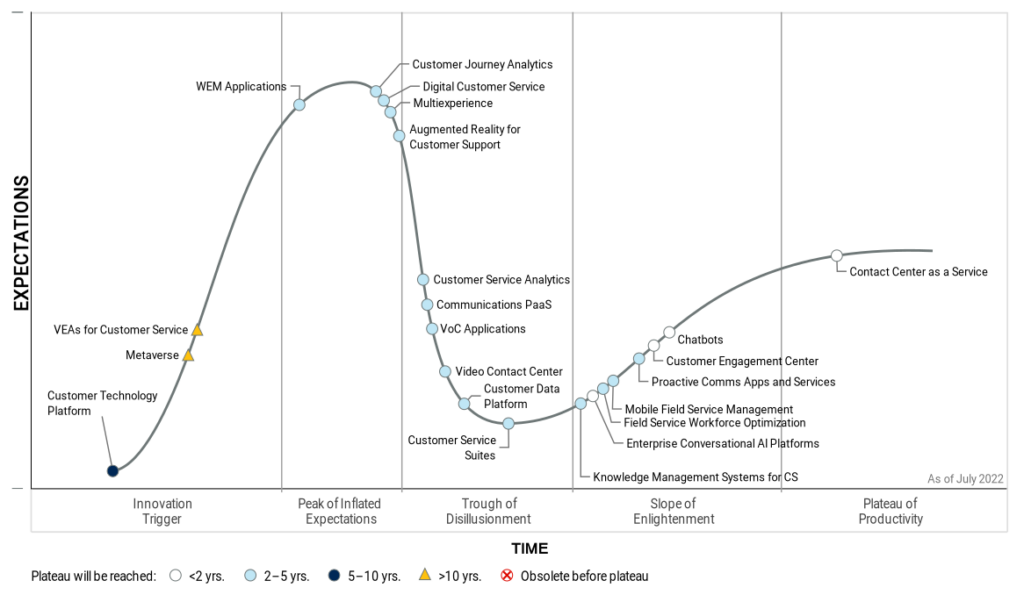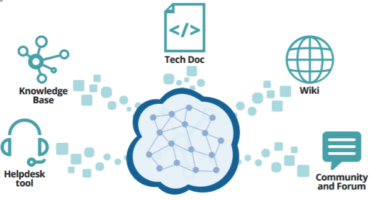We can’t overstate the importance of customer service and support. Providing excellent customer service continues to set businesses apart. In a sector that’s rapidly changing, the choice to act and evolve, or not, will mean the difference between winning and losing.
Given that 88% of executives think customer trends and preferences change faster than their businesses can keep up, it’s more important than ever to invest in customer service and support. To succeed and beat the competition, support agents will need the right knowledge tools to ensure swift resolution and user satisfaction. With the first few months of 2024 behind us, we’ve identified the trends that are most likely to affect your company’s customer service teams.
Let’s see what challenges and developments lie ahead for us this year with these 4 customer service & support trends – and one bonus trend that’s worth keeping in mind!
1. Businesses Will Invest More in AI-Powered Support Systems and Chatbots
Public hype surrounding Generative AI (GenAI) may be running wild, but beyond the craze, this valuable technology is here to stay. More than 80% of customer care leaders are already investing in GenAI or expect to do so this year. With the rapid adoption of this technology, AI-powered support tools will take center stage in the coming year.
How will this trend dominate in 2024? From understanding customer intent to augmenting support agents with auto-generated replies and providing the next generation of human-like chatbot interactions, this technology is flexible and efficient. It will help customer care teams save time and increase their first call resolution rate.
As stated in Gartner’s Hype Cycle for Customer Service & Support Technologies, companies looking for technologies that can have a near-term high impact should focus their attention on chatbots and automated support systems.

Get Started: GenAI is everywhere and for good reasons. Discover why this technology is shaking up more than just the tech teams. Dive into the various ways it can optimize your workflow. You can read about what AI can do for you in this article.
2. There Will Be Greater Emphasis on
Self-Service Options
According to McKinsey, 57% of leaders expect call volumes to increase by up to 20% over the next two years. Clearly, agents cannot cope with every query personally.
But to be fair, customers don’t always want to reach out for support. Sometimes they’d rather find the answer on their own and get on with their day. In fact, 61% state they prefer to use self-service support channels for simple issues and almost 30% say they would abandon a support issue if they can’t find the answer on their own.
We can’t expect customers to wait for a customer service representative to pick up their call or answer an email. And they shouldn’t have to since the answer is available in your company’s exhaustive, up-to-date documentation. The problem is that despite the rich content available in your knowledge base, technical documentation, or product catalog, customers may get lost looking for their specific query.
GenAI projects will elevate your self-service experience. By leveraging its understanding of individual customer data and behavior patterns, GenAI can tailor self-service options to each user’s specific needs and preferences. Additionally, it streamlines the self-service process by providing quick responses, 24/7, in any language. Its able to analyze vast amounts of data and generate automated, contextually relevant answers. This helps reduce the time customers spend searching for information and therefore increases case deflection.
Get Started: Do you have an existing portal or knowledge base? Can customers easily find answers on their own? How many support tickets could have been answered through your existing documentation? Discover how to provide excellent customer service with a self-service portal in our on-demand webinar.
3. The Rise of Omnichannel Customer Service
Customers no longer use a single channel to interact with your business. In today’s digital economy, 71% of customers enjoy using different channels depending on the situation. Business buyers typically use around 10 channels to interact with companies while consumers use about eight.
Omnichannel customer service provides a unified experience across all touchpoints customers use to engage with your product or company. Therefore, companies give customers the option to use the support channel that best suits their preferences and their needs.
Technologies have already emerged to support this rising trend. Content Delivery Platforms serve unified knowledge in any channel, including existing helpdesk tools, your documentation portal, and even community software such as Salesforce Service Cloud or Community Cloud.

Get Started: Ask yourself whether you can easily publish your content in multiple channels without reformatting that content for each channel. Hear how this company unified its content experience for all customers. See how they created an omnichannel experience where content is easily published to both Salesforce and their documentation portal.
4. Data-Driven Content and
Customer Feedback
Recently, companies focused their efforts on analyzing customer insights and feedback to develop a more customer-centric business. In 2024, the new trend is to pay attention to their product content performance with next-generation content analytics. This is a particularly key focus as 80% of customers feel that their experience with a company is just as important as its products and services.
By analyzing content performance and customer feedback, companies identify where they are excelling, and where they need to improve. This data is all available in real-time. “When we see that people spend a lot of time on a particular topic, it raises a flag. It might mean that the documentation needs attention because it’s hard to use, or that the product itself needs attention,” shared Lonnye Yancey-Smith, Executive Manager at Hexagon Asset Lifecycle Intelligence.
Similarly, GenAI-based tools will allow companies to automatically flag when there is no content available for a specific topic within their product knowledge hub, an issue that companies need to swiftly resolve due to the rising preference for customer self-service. When users receive the “no results” page in response to their search, the analytics solution will signal this knowledge gap to the tech writing team. Then, once the tech writers publish a new article and the issue is treated, the system will alert the customer support team of the update. Businesses will need to properly analyze this data to make their customer support more efficient and avoid customer frustration.
Get Started: The variety of data tools is growing. In an omnichannel environment, you need technology that measures key metrics such as sessions, users, pages, flow, and duration. However, your analytics also need to evaluate specific user behaviors and ensure continuous improvement of your content.
Bonus: Personalized and Contextualized Customer Experiences
With companies like Google or Amazon, customers expect personalized experiences. In fact, 65% of customers assume companies will conform to their changing needs. Luckily, if you’ve gotten this far then you know that tracking product content performance is trending right now. Why does this matter to personalization? According to Twilio Segment, 78% of businesses say first-party data is the most valuable reference to provide personalized experiences.
Fluid Topics recently held a webinar with Val Swisher, author of the influential book “The Personalization Paradox: Why Companies Fail (and How To Succeed) at Delivering Personalized Experiences at Scale”. There, Swisher said that “a personalized experience is when we can deliver the right content to the right person at the right time on the right device in the language of their choice”.
However, while the demand for personalization is rising, it’s nothing new. That’s why in 2024, businesses will also have to create contextualized experiences. Fabrice Lacroix, CEO of Fluid Topics, defines a contextualized experience as “giving customers, the right information about the right product, with the right configuration, at the very moment they are seeking it.”
Personalization and contextualization go hand in hand, and they will be more than just bonuses for doing business. Technologies such as Content Delivery Platforms are essential for crushing this trend. They boost your content’s impact on your customers and support teams as well as improve satisfaction.
Get Started: You need to give customer teams the right tools. That way they can proactively offer personalized and contextualized support that helps customers and closes tickets. To do this, shift the focus to delivery first and content optimization second. This approach helps you achieve quick wins and build a fast ROI while enhancing the customer journey. Check out the following webinar to gain insight into this concept.
Key Takeaways of Customer Service and Support Trends
Adopting the strategies and trends outlined above can greatly enhance your customer success and make your customer service a key competitive advantage.
For product and technical content professionals, having a customer-centric vision will help provide the best possible experience and support for their users.
Fluid Topics’ Content Delivery Platform serves your customers with the product information they need to successfully solve their issues on their own. It allows you to easily prevent questions from turning into cases, improve case deflection, and accelerate resolution. Do all of this while making the most of your product documentation.
Try it now and discover how to build efficient content experiences for your customers & support agents.
Editor’s Note: This post was originally published in January 2023. It has been completely edited and updated for accuracy and comprehensiveness.
Latest post










